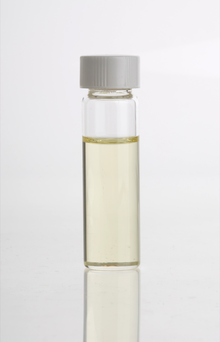Cajeput oil
This article needs additional citations for verification. (September 2012) |

Cajuput oil is a volatile oil obtained by distillation from the leaves of the myrtaceous trees Melaleuca leucadendra, Melaleuca cajuputi, and probably other Melaleuca species. The trees yielding the oil are found throughout Maritime Southeast Asia and over the hotter parts of the Australian continent. The majority of the oil is produced on the Indonesian island of Sulawesi. The name “cajeput” is derived from its Indonesian name, “kayu putih” or "white wood".
The oil is prepared from leaves collected on a hot dry day, macerated in water, and distilled after fermenting for a night. This oil is extremely pungent, and has the odor of a mixture of turpentine and camphor. It consists mainly of cineol (see terpenes), from which cajuputene, having a hyacinth-like odor, can be obtained by distillation with phosphorus pentoxide. The drug[clarification needed] is a typical volatile oil, and is used internally in doses of 2 to 3 minims, for the same purposes as, say, clove oil. It is frequently employed externally as a counterirritant. It is an ingredient in some liniments for sore muscles such as Tiger Balm and Indonesian traditional medicine Minyak Telon.
It is also used as an ingredient in inhalants/decongestants and topical pain/inflammation remedies such as Olbas Oil.
Historical note
In October 1832 while in the port of Manila, the Asiatic or spasmodic cholera suddenly made its appearance on board the USS Peacock (1828). The first case was in a sailor named Peterson, sixty-three years old. The surgeon administered six grains of opium, in three doses; bad symptoms increasing, fifteen drops of cajeput oil were given in brandy and water, and repeated in half an hour. This treatment, however, apparently did not help the patient; Peterson died about eleven hours after being stricken, as did seven others, of "the terrific and appalling effects produced by one of the greatest scourges that ever visited the world."[1]: p. 64
For fish
Cajeput is used for the treatment of bacterial or fungal infections in fish. Common brand names containing Cajeput are Melafix and Bettafix. Melafix is a stronger concentration and Bettafix is a lower concentration that makes it harder to overdose smaller fish, especially bettas. It is most commonly used to promote fin and tissue regrowth, but is also effective in treating other conditions, such as fin rot or velvet. The remedy is used mostly on betta fish.
See also
- Tea tree oil – derived from Melaleuca alternifolia
References
- This article incorporates text from a publication now in the public domain: Chisholm, Hugh, ed. (1911). "Cajuput Oil". Encyclopædia Britannica (11th ed.). Cambridge University Press.
